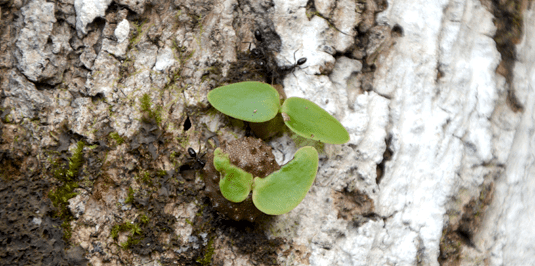You won’t find people who take greater pride in their work than farmers. Maybe for good reasons, too, considering that their sweat and blood keeps us all fed. The advent of every human civilization is tied up with agriculture. That’s the very least a race needs to master before it can move to something bigger, like writing poetry or landing spaceship or playing golf. It took our human ancestors a while before they realized the same plants they were foraging could be coaxed to sprout where they desired, at a predictable rate. That happened only some 13,000 years ago. Ants, on the other hand, have been doing it for millions of years.
World’s first farmers
Since the Pliocene Epoch, about three million years ago, an ant species native to the Fiji islands called Philidris nagasau has been farming and harvesting Squamellaria plants. These ant-favored crops look more like lichen than plants, growing inside the crevices of trees. But don’t let appearances fool you. These are still plants and the ants take all the precautions and with all the diligence a human farmer would entrust to see their crops blossom.
The ants live inside the plant’s hollow structures, the domatia, and Guillaume Chomicki, a botanist at the Ludwig-Maximilians-University of Munich, followed their lives for a couple of months. This is how he and colleagues eventually found that the ants actively and purposely gather the Squamellaria seeds and place them at strategic locations. They then fertilize the seeds with their poop. Once the plants grow, the fruits are harvested and distributed among the colony, while the seeds are yet again collected to restart the process.
Because the crops double as a nest, a colony can cover several Squamellaria plants.
“One often finds dozens of colonies, connected by ant highways, on a single tree. All of these individuals are the progeny of a single queen, whose nest is located in the center of the system,” Chomicki explains.
While Fiji’s Philidris nagasau ant look like the world’s first plant farmers, they’re certainly not the first farmers. That distinction belongs to other ants, the famous leaf-cutter ants whose ancestors have been farming fungus since at least eight million. A recent Smithsonian paper which studied the genomes of various species of attine ants as well as the fungus that they cultivate found farming could be as old as 65 million years. Other species of ants have their own livestock, herding aphids by chemically subduing them. The ants then ‘milk’ the aphids for their sugar-rich secretions.
The relation between Squamellaria and Philidris nagasau is far more specialized than anything seen in another species that practice farming. Besides being the first ant species that farms plants, their relationship is highly dependent on one another. The plants can’t draw nutrients from the soil, so they rely on the ants for fertilization. The ants, in turn, can not survive without the fruit and shelter of the plants.










